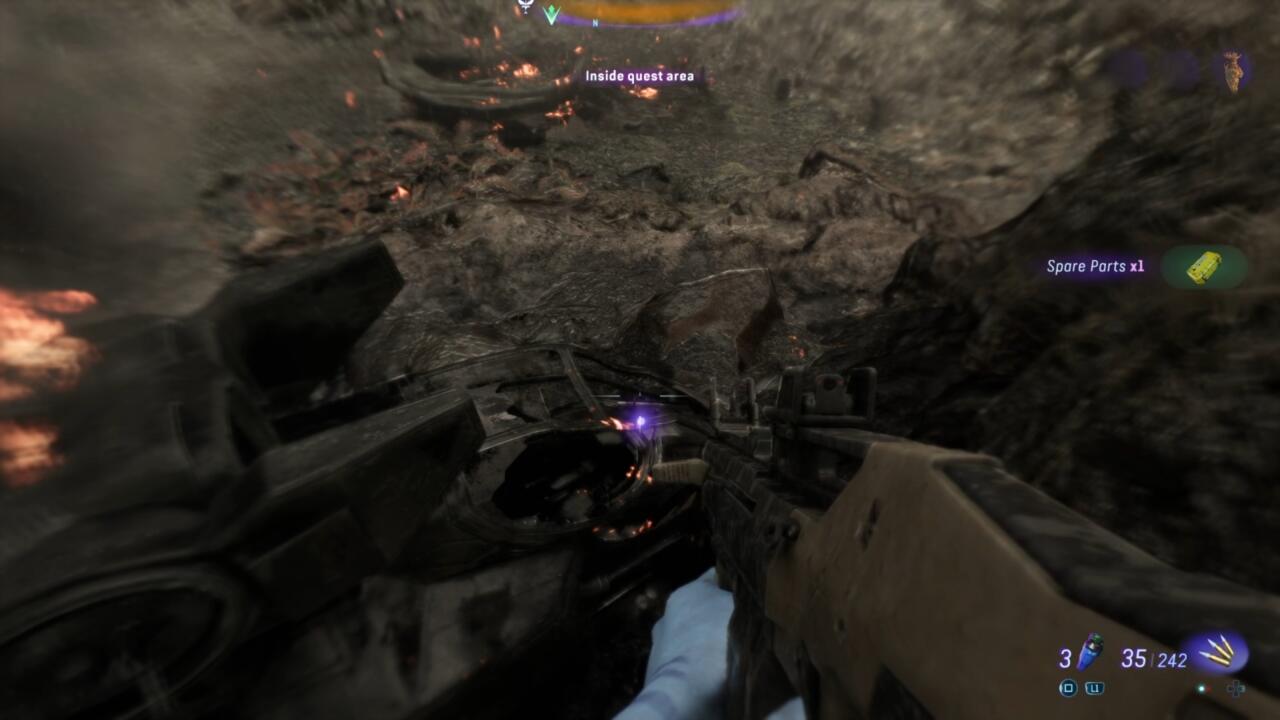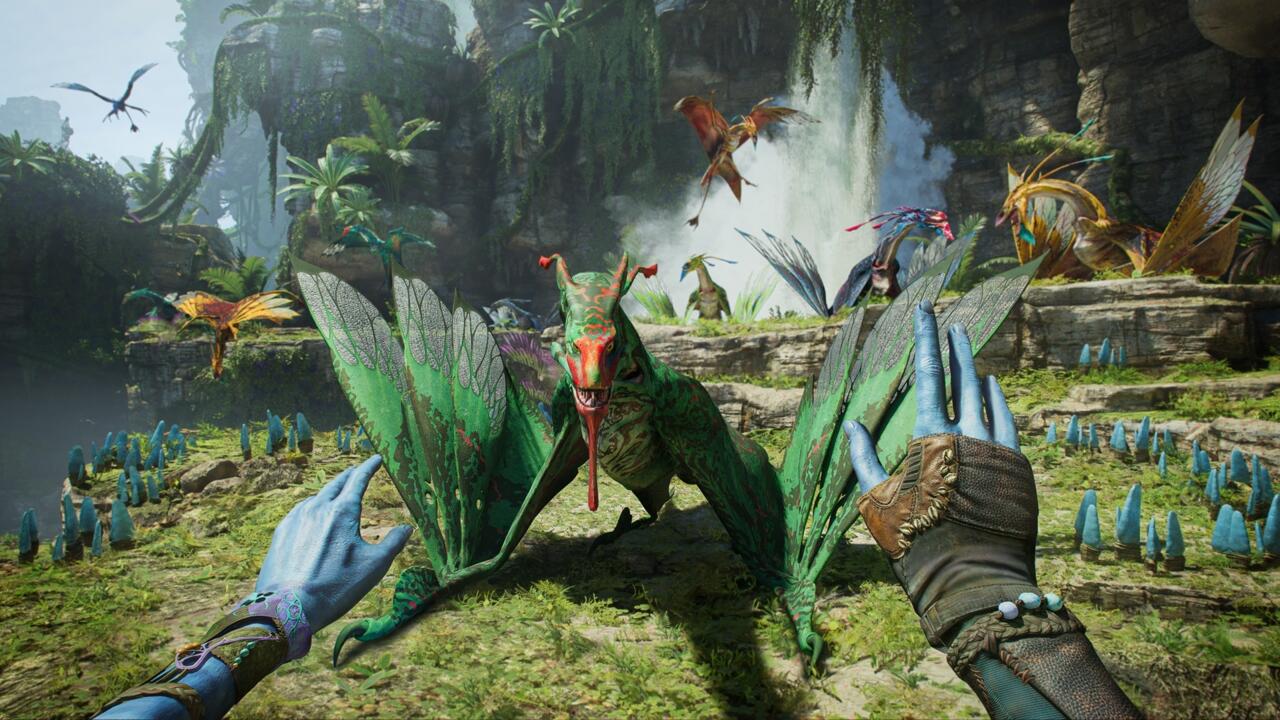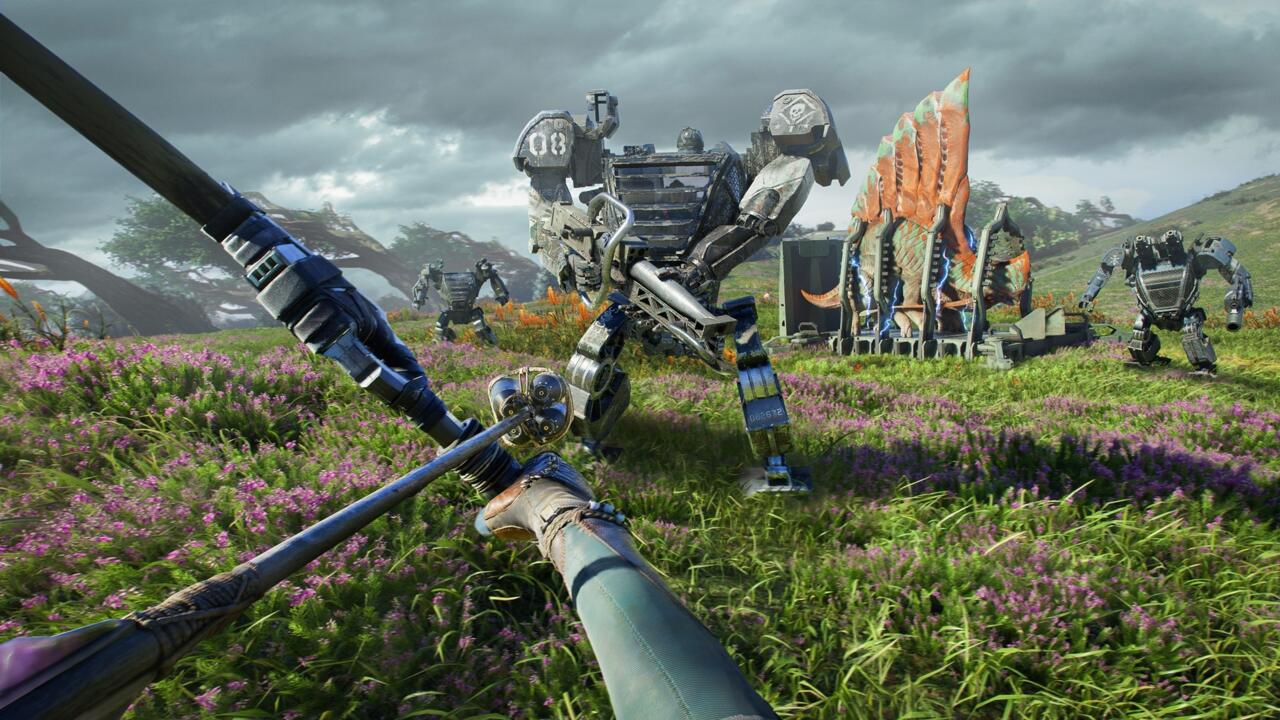Open-world games often benefit from putting players in the middle of wars and revolutions, fought across lush and fascinating worlds, where an evil force has taken control of nearly everything and must be pushed back inch by inch. Ubisoft often utilizes this formula for its open-world games, which usually feature huge and gorgeous worlds where you’re fighting a powerful, entrenched military enemy. The harsh but beautiful alien moon of Pandora, the setting of the Avatar films, is a near-perfect fit for the approach.
What’s most interesting about Avatar: Frontiers of Pandora, though, is that it might give developer Massive Entertainment an opportunity to improve on the Ubisoft open-world formula at a time when the genre is inspiring more than a little fatigue.
We played about two and a half hours of Avatar: Frontiers of Pandora, and at first glance it fits pretty neatly into the established canon of Ubisoft open-world games. You run around completing quests, gathering plants and hunting animals for crafting, and capturing bases to free the areas surrounding them from enemy control. The surface-level aspect feels a lot like the Far Cry series, but with a few RPG-focused tidbits of Massive’s Division games, plus aliens.
The massive and lush world of Pandora does a lot to make Frontiers stand apart from the rest of the Ubisoft catalog, though. It’s a gorgeous world full of weird flora and fauna, and it’s nice to have a new and unknown place to explore.
Frontiers of Pandora tells its own story that’s independent from the movies, but the basic setup is the same. You take on the role of one of the Na’vi, the indigenous race that lives on Pandora, as you fight off the invading human forces of the industrialized RDA. The whole story takes place on the Western Frontier, a continent that hasn’t previously appeared in any Avatar stories, shortly before the events of Avatar: The Way of Water.
Our hands-on time with Frontiers of Pandora focused on a few story quests that helped give a sense of how you’ll interact with the world. There’s a not-quite parkour feel to being a Na’vi–you’re bigger than a normal human and can clamber and leap over rocks and trees to maintain your speed. There are lots of opportunities to climb rocks and trees everywhere, and you can charge up a jump for decent height while also using a little air dash to cover gaps–it’s basically a triple jump.

Finding your way around is done with « Na’vi vision, » which highlights creatures and certain elements in the world around you, while also briefly highlighting your destination points. Quest objectives describe locations by their names and give you directions using landmarks and compass points, with a focus on pushing you to rely on checking an in-game map to get the gist of where you’re heading, and exploring along the way. It’s a little confusing at first, especially as you try to acclimate yourself to the different areas and landmarks of an unfamiliar landscape. We found that it was easy to get turned around and lost at times, or to overshoot a destination and have to spend a few minutes staring at the map to re-orientate.
Na’vi vision also lets you mark plants and creatures to gain information about them, which you can add to a hunter compendium menu. Reading up on ingredients and animals gives you the information about where they congregate and how to find them, and even lets you highlight them in Na’vi vision, making it easier to find what you need. Plants and animals have different rarity levels, which can fluctuate on the day/night cycle and even weather, so there’s a lot to keep track of to get the things that you might need.
In general, Frontiers of Pandora uses Na’vi vision to emphasize spending your time in its alien world, rather than just pointing you toward the next navigation point or filling your screen with icons to chase down. In one side-quest, we were tasked with finding a missing RDA defector who crashed a VTOL as he tried to bring medical supplies to the Na’vi resistance. Locating him was a multi-stage affair that required us to find his crash site, clear out the RDA who were also searching for him, and then investigate the crash yourself.
There’s a bit of detective work here. You needed to find and select different objects in the crash site, like a parachute tangled in a tree, a ripped-up flight suit, or the VTOL itself, and « connect » the pieces of evidence that go together so your character could draw conclusions. Once you figured out what happened, your character made the inference that the defector was injured and trailing a certain scent from the medical supplies he used to patch himself up. You could then use Na’vi vision to see the scent trail and follow it. These aren’t elements that are exactly new or unheard of in open-world games, but Frontiers of Pandora deploys them with the effort to make you feel like you’re a hunter in the forest whose understanding of how this world works gives you an edge, and it’s refreshing that you’re asked to think through these puzzles rather than just look for the next icon or quest objective.

The slightly less signposted nature of Frontiers of Pandora tends to work in its favor. One of the quests in the preview session put us in an extremely Avatar scenario: finding and bonding with an ikran, one of the flying creatures the Na’vi use to get around. The mission required climbing into the islands that float above Pandora’s landscape, with the occasional need to solve puzzles in order to find the path forward. These included finding big paddle-like leaves that launch you across large gaps, and opening pathways blocked by huge shell-like plants.
These shell-like plants require you to follow vines around the environment to reach leaves that you can activate, which will eventually remove what’s blocking the way. The demo we played didn’t provide any explanation as to how to solve these puzzles, which instead suggested you’ll need to rely on your wits and your Na’vi vision to figure out how to proceed. Like the navigation, it was a little confusing at first, but the reliance on finding your way helps to highlight the feeling of having the special abilities and connection to the world that the Na’vi enjoy.
The question overall is how well these attempts to get you immersed in Pandora actually work, which is tough to tell with just a short look at the game. Our experience for those couple of hours in Frontiers of Pandora was that getting lost was something that could happen frequently, and that the game often asks you to track down some small plant or object that can be tough to locate in its incredibly dense world. That could be pretty frustrating, since there seem to be a huge amount of plants and animals you’ll use as crafting materials. We didn’t spend much time with the crafting systems, though. And the lack of understanding about how best to navigate and to find important materials could also just be a function of dropping into the game in a middle point, rather than getting tutorialized in the early going the way a player normally would.
Once you’ve bonded with an ikran, you can call it whenever you want, which helps make the huge world of Pandora feel manageable. It also offers you some cool abilities to use in combat, which puts a heavy emphasis on speed, maneuverability, and unconventional attack angles.


As a Na’vi fighter, you’re fast and powerful, but you’re still vulnerable to the bullets and bombs of the RDA, who have no chill. You might be physically superior, and quite a bit bigger, than any human you might run up against, but they’re packing VTOLs, mech suits, and assault rifles. The fact that you’re outgunned and powerful but not invincible provides an incentive to think about how you approach fights in Frontiers of Pandora.
You can always go in guns blazing, but–at least in the quest we played that sends you to clear out an industrial RDA base–stealth and hit-and-run tactics seem like better options. Stealth in Ubisoft open-world games is always an option but not strictly necessary, often because you’re usually so well-armed that you can smash through just about any group of soldiers that decides to mess with you. Here, your relative squishiness brings a feeling that being sneaky and smart is as important to staying alive as being a crack shot.
We played a story quest that introduced taking down bases, but as in other open-world games, you’ll also encounter them as you wander the world and can take them on whenever you want–assuming you have the right gear level. Some bases are well above what you can handle, and your character will even call out the need to prepare before approaching them. RDA bases pollute the area around them, enraging or killing wildlife and generally sucking the color out of Pandora, and you can only clear it up by destroying the base outright. That usually means heading inside and flipping a few switches scattered around the place to cause it to overload. Of course, all the RDA bases are full of enemies, and getting spotted will lead to alarms that put everyone on alert and draw reinforcements.
Sneaking and combat feel pretty similar to other Ubisoft games in the genre; enemies have indicators that let you know when you’ve been spotted, it’s possible to lose people if you break line-of-sight and hide, and you carry a bow that can kill RDA troops silently so their buddies don’t notice. Getting spotted, though, really highlighted how Frontiers of Pandora’s systems come together. Running, jumping, and climbing around are essential for staying alive, and while you’re fighting mechs and other mechanical enemies, they also go down pretty quickly, so you never feel like you’re overwhelmed by fighting bullet-sponges that outclass you in survivability. Mechs and other enemies can be destroyed with well-placed shots to their fuel tanks, as well, so there’s a skill component that’s a great pairing with the need to keep moving and using cover and climbing to get the advantage on the RDA. There are a surprising number of ways to take down mech suits, including breaking the glass cockpit with a heavy bow to get to the pilot, triggering environmental hazards to take them down, or hacking a few of them and then executing a disabling command.


Our hands-on time provided a decent look at Avatar: Frontiers of Pandora, and what we saw was promising. It generally feels like Massive is using the Avatar license as a chance to expand on the usual Ubisoft approach to open-world games. A lot of the usual formula elements are present, but with an effort to move away from the hand-holdy nature of many of those games. At its most heightened moments, that approach works pretty well, with Frontiers of Pandora providing some fun, fast-paced action and a beautiful world to explore.
The question is whether a huge open world can operate without all those hand-holdy user interface elements and navigation icons. And while ideas like Na’vi vision feel like a step in the right direction, they might offer a different kind of hand-holding instead of less: a kind that requires you to just hold down a button to see what you’re supposed to do, rather than having it superimposed on the screen at all times. But Avatar: Frontiers of Pandora takes place in a huge, gorgeous, and strange world, and if it can strike the right balance in helping you explore it without telling you how to do so, it could be a pretty exciting new frontier in open-world games.
The products discussed here were independently chosen by our editors. GameSpot may get a share of the revenue if you buy anything featured on our site.









